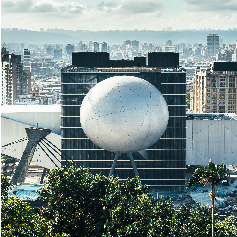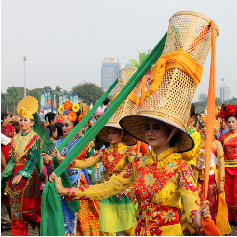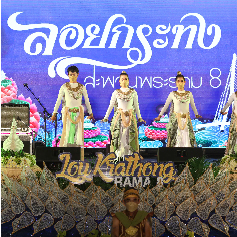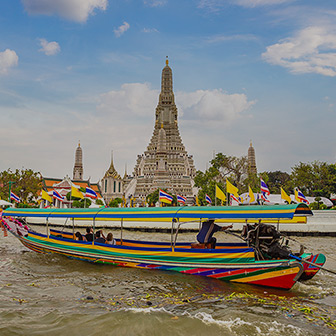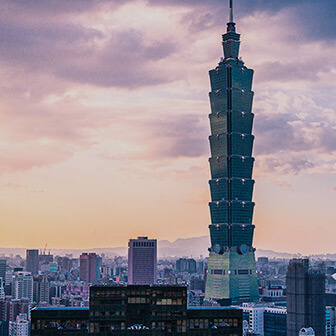
Feature Theme
Information on each city will be introduced in the seven themes of History, Nature &
Outdoor, Arts & Cultures, Traditional crafts, Cuisine,
Festivals & Events and
Videos.
Feature Theme
“Cuisine”
Traditional cuisine and local food from each city are introduced. You can also get insights on the food culture.
Bangkok
Thai Food: The Regular Recipe That Feeds the World
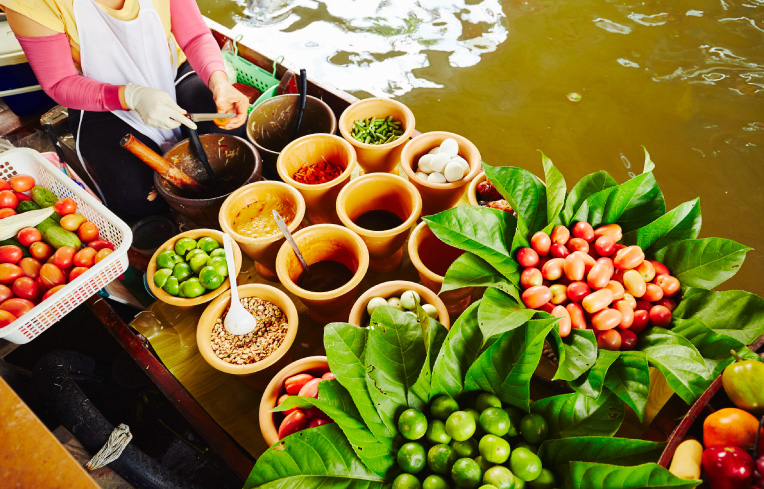
There is fish in the water and rice in the fields.? This over-700-year-old usual saying among Thais since the Sukhothai period portrays Thailand as not only an agriculture-based country but a very fertile place to live in. Our staples are rice, fish, fresh vegetables and other produce that comprise most of the ingredients. A good recipe for Thai dishes and desserts naturally contains some certain herbs and spices that nurture your health. A Thai family knows well that food is medicine in itself and so spreads out the knowledge to the world. Though a higher class seems rather intricate, even more visitors do not want to miss out our basic Thai cooking lessons. Tom-yam-kung, for instance, is one of the most popular and favourite Thai dishes among our curious visitors. Just try to have some other savoury and sweet dishes and learn how having a Thai meal looks like: tot-man-pla-krai, kaeng-khiaw-wan-nuea, tom-kha-kai, nam-phrik-long-ruea, mi-krop, som-tam-thai, phat-thai-kung-sot, khao-niaw-ma-muang, kra-thon-loi-kaew, lot-chong-nam-ka-thi, luk-chup, kha-nom-khrok, etc. Enjoy!
Delhi
With an emphasis on freshness and an attention to seasonal ingredients, Japanese cuisine offers something for everyone

Festivals like Qutub and Ananya have famous monuments as picturesque venues for the melodies and graceful dances. Concerts like Bhakti Utsav are held in open air venues like Nehru Park. When attending festivals like Jahan-E-Khusrau, Sufi hits like Allah-hu and mastqalandar fill the air, it can be rightly said that the capital is where it is all happening.
Hanoi
Hanoi Cuisine is rushing to the forefront of the city's renaissance and resurgence.
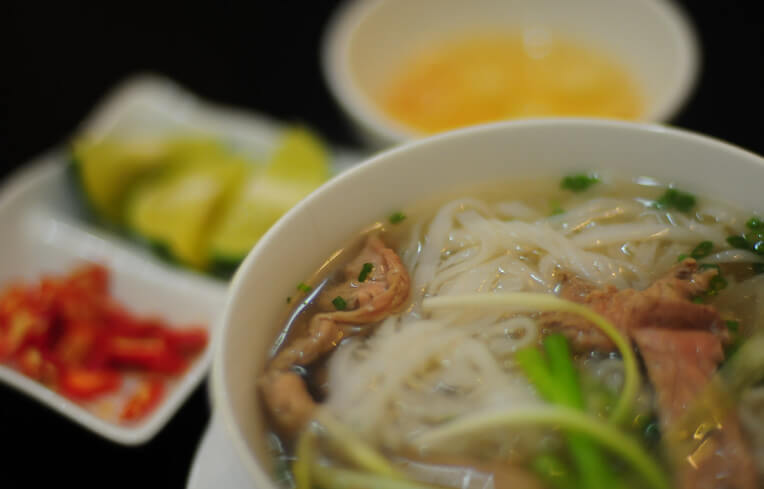
Voted as one of the world's top five spots for dining, thanks to its unique street dishes, Hanoi's cup, or plate in this case, virtually runneth over gastronomic options. Vietnamese and French give way to Italian, Belgian, Japanese, Korean, Thai and Indian dishes.
Jakarta
Whatever your preference – hot and spicy, piquant seafood dishes, crispy vegetables, or zesty curries – the perfect meal waits to delight. With so many choices to satisfy your appetite, be prepared to savor a taste sensation like never before.
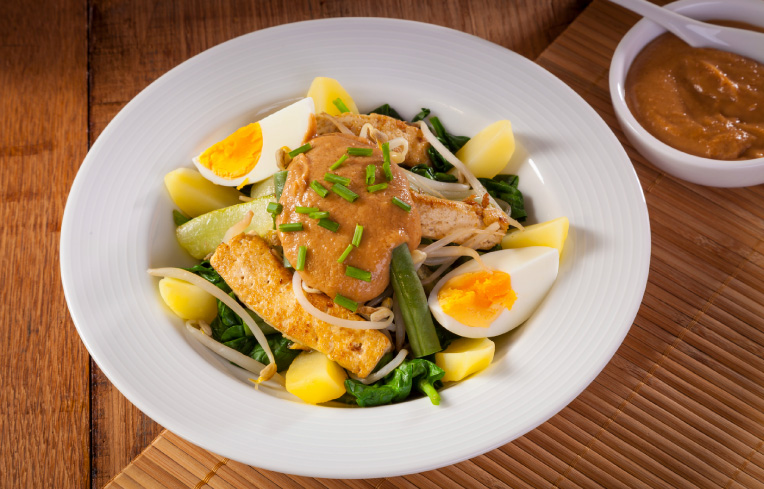
*Nasi Uduk
Nasi Uduk should be on your must-try list. It is a dish of rice cooked in
coconut milk complemented with traditional fried chicken.
*Kerak Telor
Kerak Telor is a snack made of eggs and chunks of burned rice.
Kuala Lumpur
haute cuisine or casual hawkers-either way, a feast for the senses
*World cuisinve
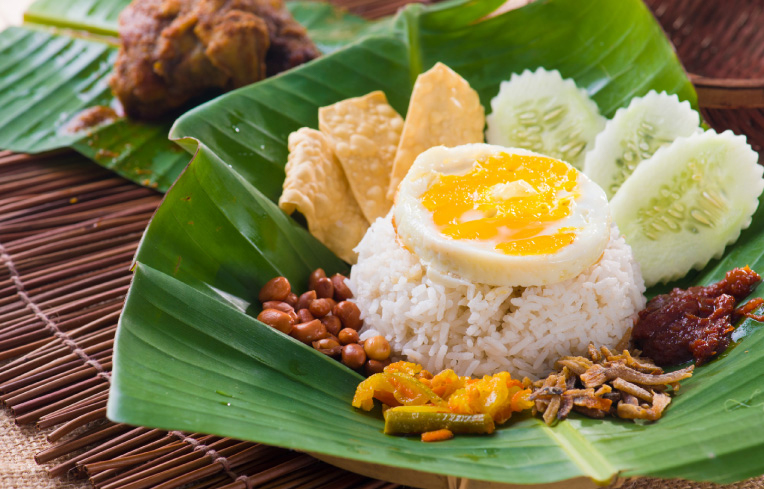
Food is, quite unashamedly, one of the primary currencies in Kuala Lumpur. Hawker centers can be found in almost every corner of the city, serving every type of food in Malaysia – and most, if not all, are open 24 hours. The electic jumble of KL-ites and expats alike grazing merrily on local favorites like nasi lemak and satay make for quite a sihgt, especially after a good night of intense entertainment. Kuala Lumpur is also a hotbed for world cuisine. The dizzying array of fine dining establishments serves up a delectable choice for even the most refined of taste buds. From the best in Mediterranean fare to the most exotic of Chinese cuisine, Kuala Lumpur is fast stamping its mark as a culinary capital.
Metro Manila
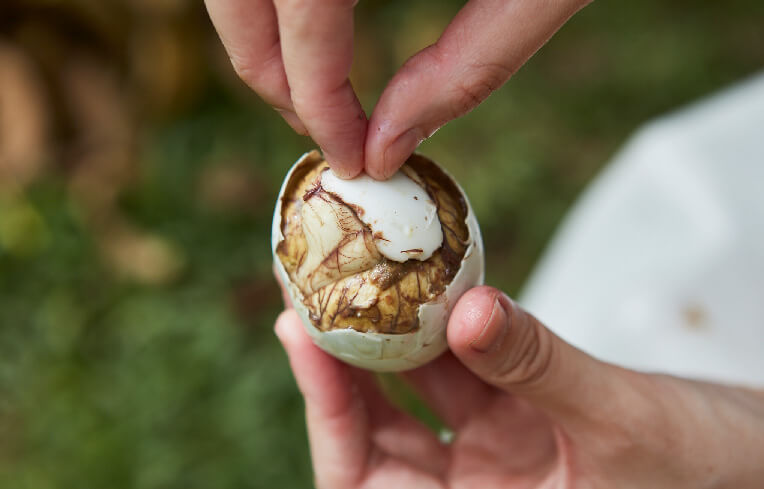
Food is a huge part of Filipino culture. Filipino cuisine is an exotic, tasteful fusion
of oriental, European, and American culinary influences.
Metro Manila is home to
famous Filipino cuisines like adobo, lechon, sinigang, and kare-kare. You must also try
“Balut,” one of the country's exotic delicacies.
Seoul
Uniquely Korean: A Distinct Cuisine Bursting with Freshness and Flavor
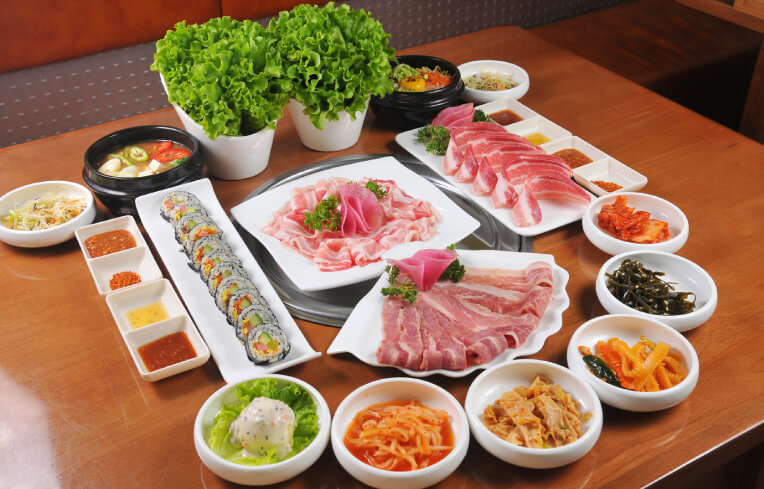
It is with good reason that Korean cuisine is so popular: the spicy dishes comprised of meat, fresh vegetables and fiery sauces are not only delectable, but are also healthy and cheap, so there is no need to worry about your waistline your wallet. Meander through Seoul's obscure alleyways and marvel at the abundance of restaurants – from modern eateries serving pork barbeque with leafy greens to ancient, rustic establishments serving unfussy vegetarian dishes, such as bibimbap made of rice and mixed with vegetables, which mimic those eaten by monks centuries ago.
Taipei
Shop Taipei! Dine the world!
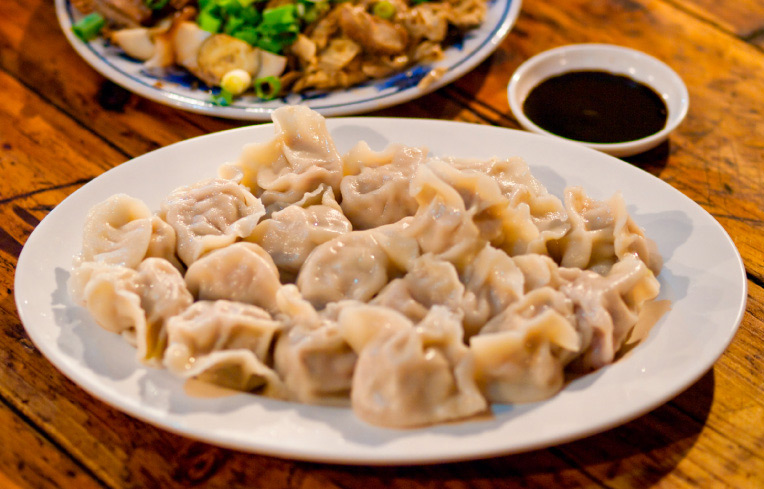
*Thousands of eateries Few cities in the world can rival Taipei when it comes to dining out. There are literally thousands of eateries throughout the city catering to every taste and budget, from Asian to western – the haute to the simply hot. You should not miss the delights of the Taipei night markets, which come to life at several places in the city. Streets are lined with old stores or street stalls, selling authentic traditional Taiwanese snacks, Chinese herbal medicines, and handicrafts.
Tokyo
No one would disagree that food is one of the highlights of a trip to Tokyo. Tokyoites
are passionate about their food and take pride in the fact that even the humblest dishes
are made to perfection without skimping. It is no longer a surprise that there are more
Michelin-starred restaurants here than anywhere else in the world.
Dining in the
most elegant restaurants in Tokyo can be a bit difficult right now. If you do, just
think of the programs I am recommending here, and your next visit to Tokyo will be more
colorful than ever. I'd like to introduce two great food-related programs that will make
your trip a treasured experience for the discerning and sophisticated world traveller.
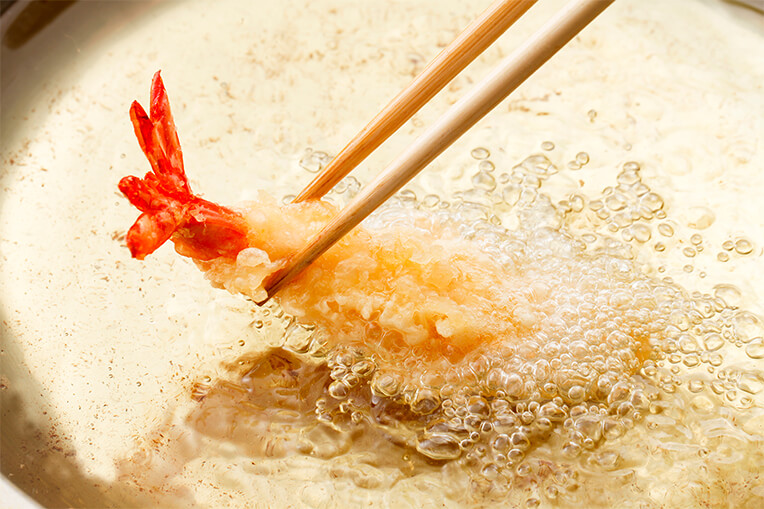
*Tempura
Tempura is a very popular Japanese dish, created by coating seafood and vegetables in a
batter made from flour, water and eggs, which are then deep fried in oil. The result is
a distinctive crispy batter on the outside, contrasted with tender and fluffy contents
inside, which are then dipped in dashi stock or a slightly sweet tentsuyu dip. The
flavor can be further accentuated by adding a little salt. Another of tempura’s appeals
is that it can be enjoyed not just on its own, but in a variety of styles, including
being served on top of soba or udon noodles, or over rice. It is believed that tempura
was first introduced to Japan by Portugal, in the Muromachi period (14th to 16th
centuries). From the Edo period (1603-1868) onwards it became a popular dish for
ordinary people and special tempura restaurants also started to appear from that time.
While tempura is a dish that can easily be enjoyed as home-cooked food, it is in
specialty restaurants where you can sample tempura created with the attention to detail
of true craftspeople. Each piece of tempura at such eateries is carefully fried one by
one by craftspeople who have received ten years of training, and is characterized by its
highly fragrant flavor, light and crispy texture, and lack of any hint of oiliness.
Using only fresh oil, each piece is lightly coated in batter, before being gently fried
at just the right temperature. The deliciousness that is produced through the skills of
these craftspeople is precisely what moves people’s hearts and keeps the food culture of
Japan alive and well today.
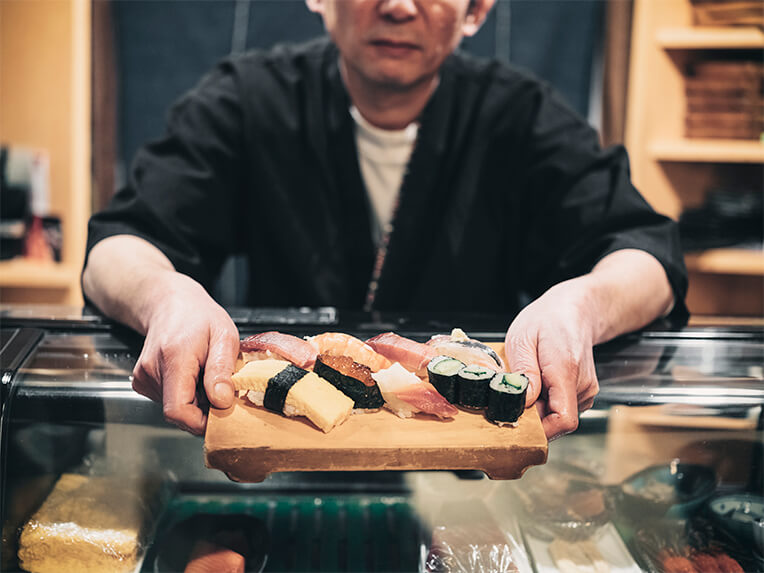
*Sushi
Such is a Japanese dish that combines rice mixed with vinegar, salt and sugar, known as
shari, with seafood and other ingredients, known as neta. The ingredients used as neta
also include meat, vegetables and eggs. Sushi could be said to be the quintessential
Japanese cuisine, but in fact it traces its origins back to around the 4th century BCE
in Southeast Asia. It is there where mountain-dwelling tribes are said to have created
nare-zushi, a preserved food made by fermenting fish with salt and rice. Subsequently
nare-zushi is thought to have made its way to Japan together with rice cultivation from
China. It was in the Edo period (1603-1868) that the style of sushi that is familiar to
us today, known as nigiri-zushi (hand-formed sushi), was established. It was from these
origins that the various kinds of sushi developed. While the most famous type of sushi
is certainly nigiri-zushi, there are also inari-zushi, oshi-zushi, and maki-zushi. The
California roll, which originated in the United States, is another example of a dish
derived from sushi. Perhaps the greatest appeal of nigiri-zushi is the rich umami flavor
of the neta, combined with a texture that seems to unravel and melt the instant that you
put it in your mouth. These textures are created by the hands of sushi chefs, each of
whom have spent years refining their techniques, including the amount of air used when
making the sushi, the speed at which it is made, and even its firmness. It is these
skills that today captivate people around the world.
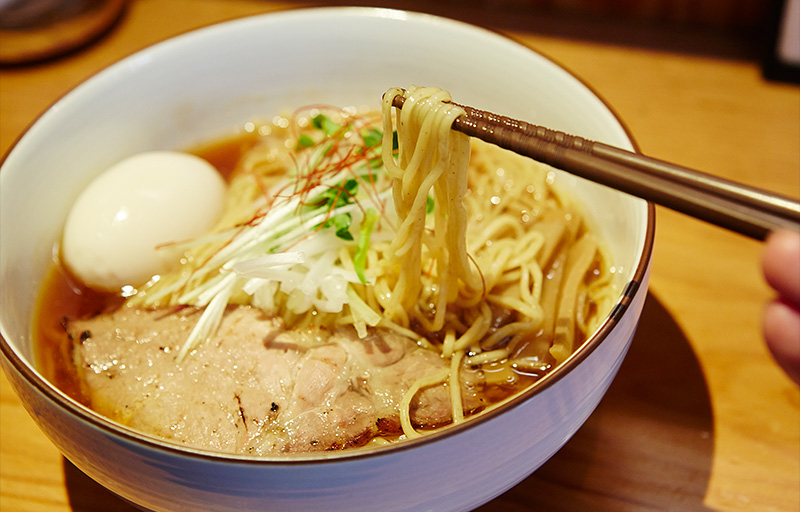
*Ramen
Everywhere in Tokyo you will find ramen shops, where you can enjoy various
flavors. It is recommended to visit a ramen shop if you are in Tokyo.
▼For more details
https://www.gotokyo.org/en/story/guide/oodles-of-noodles-a-guide-to-eating-ramen-in-tokyo/index.html
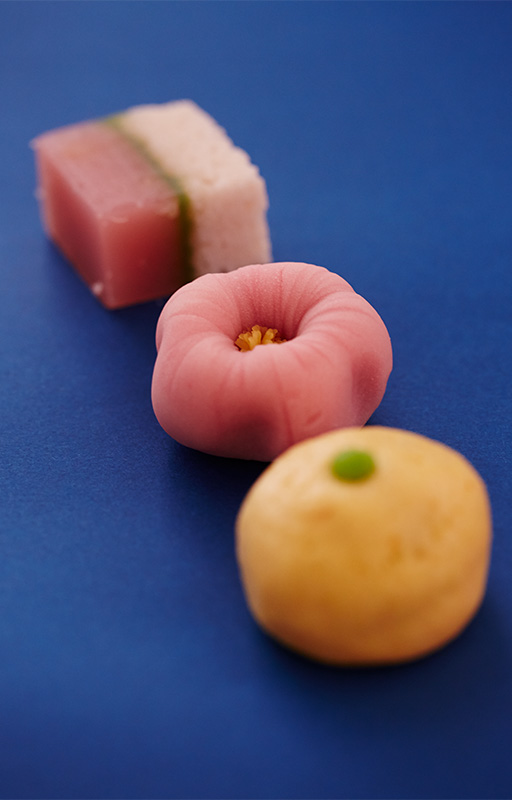
*Japanese sweets
Why not enjoy exquisitely designed, beautiful wagashi (traditional
Japanese sweets) in Tokyo?
▼For more details on Japanese food, including wagashi
https://www.gotokyo.org/en/see-and-do/drinking-and-dining/japanese-cuisine/index.html
Other feature theme
City Profile
Let's explore Asian cities!
Let's explore
Asian cities!
This campaign is conducted through the cooperation of following cities


